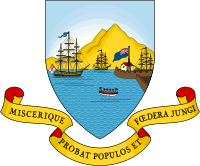Coat of arms of Trinidad and Tobago
| Coat of arms of Trinidad and Tobago | ||
|---|---|---|
Shield Per chevron enhanced sable and gules, a chevronel enhanced argent between in chief two hummingbirds respectant Or and in base three ships of the period of Christopher Columbus also Or, the sails set proper. | | |
| Supporters | A scarlet ibis and a cocrico, both proper and with wings elevated. | |
| Compartment | Two islands arising from the sea.[1] | |
| Motto | "Together we aspire, together we achieve" | |
The coat of arms of Trinidad and Tobago was designed by a committee formed in 1962 to select the symbols that would be representative of the people of Trinidad and Tobago. The committee included artist Carlisle Chang (1921–2001) and carnival designer George Bailey (1935–1970).[2][3]
Design
The palm tree crest at the top of the coat of arms was taken from Tobago's coat of arms before it was joined in political union with Trinidad. The shield comprises the same colours (black, red, and white) as
Holy Trinity. The island rising out of the waters beneath the Cocrico represents Tobago. Below these birds is the nation's motto, "Together We Aspire, Together We Achieve." It was designed by Carlyle Chang Kezia and George Bailey. [4]
Historical
| Colony of Trinidad and Tobago | ||
| Emblem | Period of use | Notes |
|---|---|---|

|
1889–1958 | The badge of the crown-colony depicts the harbour of white ensign and a boat with crew in the foreground. In base is the motto MISCERIQUE PROBAT POPULOS ET FOEDERA JUNGI, chosen by Sir Ralph Abercromby who captured Trinidad from the Spanish in 1797. The motto is quote from Virgil's Aeneid (Book IV, Line 112): ‘Miscerive probet populos, aut foedera iungi ’(He approved of the mingling of peoples and their being joined together by treaties).
|

|
1958–1962 | Placed on a heraldic shield with the motto on a ribbon, the badge of Trinidad was adopted by Letters patent of the 13 of October 1958 as the coat of arms of the colony. However the arms was not retained after Independence in 1962. |
See also
References
- ^ "The Coat of Arms". The Government of Trinidad and Tobago. Archived from the original on 2019-09-05. Retrieved 2019-01-23.
- ^ "Carlisle Chang (1921–2001)" Archived 2015-07-11 at the Wayback Machine, NALIS.
- ^ "Coat of Arms", The National Identity Guidelines of the Republic of Trinidad and Tobago (Ministry of National Diversity and Social Integration, Government of the Republic of Trinidad and Tobago), p. 4.
- S2CID 57571669.
